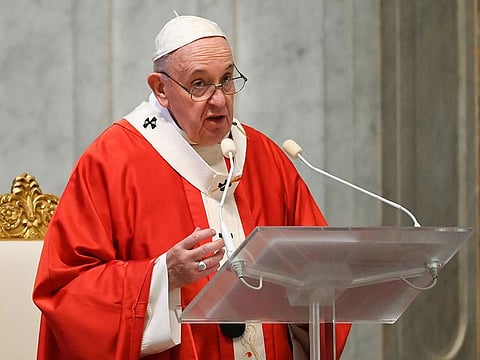Pope Francis’ health after 10 years in the job: Slower steps, same determination
Pope Francis marks 10th anniversary of his pontificate on March 13

Vatican City: Ten years ago when he became the first pope from Latin America, the former Cardinal Jorge Mario Bergoglio had a spritely step and a slimmer girth.
Today Pope Francis, 86, is using a cane and a wheelchair because of a persistent knee ailment and his waistline has noticeably increased due to a more sedentary lifestyle in the Vatican that began even before his leg problem.
But the leader of the world’s nearly 1.4 billion Roman Catholics - marking the 10th anniversary of his pontificate on March 13 - appears to be in good and steady overall health for a man of his age.
“You don’t run the Church with a knee but with a head,” he reportedly told an aide after he began sometimes using a wheelchair in public for the first time on May 5, 2022.
Last July, returning from a trip to Canada, Francis acknowledged that his advancing age and his difficulty walking might have ushered in a new, slower phase of his papacy.
But effectively he has not slowed down. After Canada, he went to Kazakhstan in September, Bahrain in November and made a gruelling trip last month to Democratic Republic of Congo and South Sudan.
He is already committed to visiting Hungary next month, Portugal in August and the French city of Marseille in September. He has said if it can be arranged, he would want to then fly from Marseille to Mongolia.
Francis alternates between using a cane and a wheelchair and he has continued with the same number of private and public audiences as before his knee became a constant problem last year.
Cardinal Kevin Farrell, an Irish-American Vatican official, has called the pope a great example to elderly people facing mobility issues.
“He accepts his limitations at this moment with a great spirit and a great heart. I think he is an example to all of us.
We should not hide the fact that with age comes a lessening of our ability to play an active part in the life of the world today,” Farrell told reporters last year.
No plans to bow out
One main difference with the past is that since April 2022, the pope has not been the main celebrant at public Masses, which would force him to stand for hours. He has delegated that role to a senior cardinal, while continuing to preside over the services and deliver a homily.
Francis told Reuters in an interview in July last year that he preferred not to have an operation on his knee because he did not want a repeat of long-term negative side effects from anaesthesia he suffered after an intestinal operation in July 2021.
He said he had no plans to resign anytime soon and that if he eventually did it would be for serious heath reasons, such as if he were gravely incapacitated.
Asked by Italian Swiss television RSI in an interview to be broadcast on March 12 what condition would lead him to quit, he said “A tiredness that doesn’t let you see things clearly. A lack of clarity, of knowing how to evaluate situations”.
In the 2022 interview with Reuters he also dismissed as “court gossip” rumours that cancer had been found during the 2021 operation for diverticulitis, a colon condition that is common in the elderly.
Two months ago, he said the condition had returned and that it was causing him to put on weight but that he was not overly concerned. He did not elaborate.
Francis had part of one lung removed because of an illness more than 60 years ago when he was a young man in Argentina, but that has not appeared to have been a factor in his overall health since then.
Sign up for the Daily Briefing
Get the latest news and updates straight to your inbox



